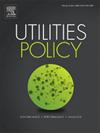欧盟碳边界调整机制对欧盟与能源共同体缔约方电力贸易的影响
IF 4.4
3区 经济学
Q3 ENERGY & FUELS
引用次数: 0
摘要
欧盟排放交易体系(EU ETS)是一个为二氧化碳排放定价的市场机制,推动欧盟能源部门和碳密集型工业的脱碳。为进一步加强欧盟碳排放交易体系,防止碳泄漏,欧盟推出了碳边界调整机制(CBAM)。CBAM在没有实施碳排放交易机制或碳定价的情况下,对从第三国和地区进口某些CBAM商品(如电力)征收关税。本文考察了在波斯尼亚和黑塞哥维那(BA)引入二氧化碳定价的影响,波斯尼亚和黑塞哥维那是与欧盟电力市场相连的第三个国家,但没有建立碳排放交易体系,以及它与克罗地亚(HR)的电力贸易,克罗地亚是一个建立了欧盟碳排放交易体系的欧盟成员国。这些分析是使用多区域和多部门单位承诺优化模型Dispa-SET进行的,其主要目标是在CBAM框架下提供二氧化碳定价对波斯尼亚和黑塞哥维那与克罗地亚之间能源市场相互作用的影响。该研究考察了100种情景,每种情景都考虑了不同的二氧化碳、褐煤和化石气价格,并分析了诸如电力进出口动态、区域平均电价、总系统成本和每个区域化石电厂的负荷持续时间曲线等因素。结果表明,低廉的化石天然气价格减少了波斯尼亚和黑塞哥维那褐煤电厂的运营,而引入二氧化碳定价导致了从电力出口国向进口国的转变。跨境线路拥塞分析表明,CBAM系数越高,拥塞加剧,需要基础设施升级。在二氧化碳价格高企的情况下,HR-BA地区的电力成本大幅上升,这强调了平衡二氧化碳定价策略和更多可再生能源部署的必要性。本文章由计算机程序翻译,如有差异,请以英文原文为准。
Impact of the EU Carbon Border Adjustment Mechanism on Electricity Trade with Energy Community Contracting Parties
The European Union Emission Trading System (EU ETS) is a market mechanism that prices CO2 emissions, driving decarbonisation in the EU energy sector and carbon-intensive industry. To further enhance the EU ETS and prevent carbon leakage, the EU has introduced the Carbon Border Adjustment Mechanism (CBAM). CBAM imposes a duty levy on importing certain CBAM goods, such as electricity, into the EU from third countries and territories without implementing the ETS mechanism or carbon pricing. This paper examines the impact of introducing CO2 pricing in Bosnia and Herzegovina (BA), a third country connected to the EU electricity market without an ETS, and its electricity trade with Croatia (HR), an EU member state with an established EU ETS. The analyses are conducted using the multi-zonal and multi-sector unit commitment optimisation model Dispa-SET, with the primary goal of providing insights into the implications of CO2 pricing on the energy market interactions between Bosnia and Herzegovina and Croatia under the CBAM framework. The study examines 100 scenarios, each considering various CO2, lignite, and fossil gas prices, and analyses factors such as electricity import/export dynamics, average electricity prices in the zones, total system costs, and load duration curves for fossil power plants in each zone. Results indicate that low fossil gas prices reduce lignite plant operations in Bosnia and Herzegovina, and introducing CO2 pricing causes a transition from an electricity exporter to an importer. Cross-border line congestion analysis reveals that higher CBAM factors increase congestion, necessitating infrastructure upgrades. Electricity costs in the HR-BA zone rise substantially under high CO2 prices, emphasising the need for balanced CO2 pricing strategies and more deployment of renewables.
求助全文
通过发布文献求助,成功后即可免费获取论文全文。
去求助
来源期刊

Utilities Policy
ENERGY & FUELS-ENVIRONMENTAL SCIENCES
CiteScore
6.80
自引率
10.00%
发文量
94
审稿时长
66 days
期刊介绍:
Utilities Policy is deliberately international, interdisciplinary, and intersectoral. Articles address utility trends and issues in both developed and developing economies. Authors and reviewers come from various disciplines, including economics, political science, sociology, law, finance, accounting, management, and engineering. Areas of focus include the utility and network industries providing essential electricity, natural gas, water and wastewater, solid waste, communications, broadband, postal, and public transportation services.
Utilities Policy invites submissions that apply various quantitative and qualitative methods. Contributions are welcome from both established and emerging scholars as well as accomplished practitioners. Interdisciplinary, comparative, and applied works are encouraged. Submissions to the journal should have a clear focus on governance, performance, and/or analysis of public utilities with an aim toward informing the policymaking process and providing recommendations as appropriate. Relevant topics and issues include but are not limited to industry structures and ownership, market design and dynamics, economic development, resource planning, system modeling, accounting and finance, infrastructure investment, supply and demand efficiency, strategic management and productivity, network operations and integration, supply chains, adaptation and flexibility, service-quality standards, benchmarking and metrics, benefit-cost analysis, behavior and incentives, pricing and demand response, economic and environmental regulation, regulatory performance and impact, restructuring and deregulation, and policy institutions.
 求助内容:
求助内容: 应助结果提醒方式:
应助结果提醒方式:


